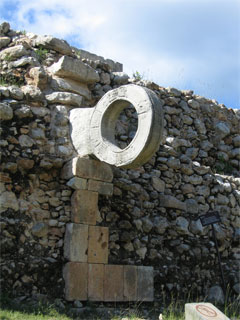
Spring has sprung, Little League players are swinging their bats and baseball is in the air. Baseball, football, basketball, hockey, soccer (called football in the rest of the world), these are the games most North Americans think of when the subject of sports comes up. But team sports is not a concept which arrived in the Americas with the landing of Columbus. For almost 3000 years before the coming of the Europeans, teams in Mesoamerica, the region which extends from what is now Mexico south through Nicaragua, were playing ball in a game that was truly was a matter of life or death.

Today, when visiting the ruins of these ancient cultures, travelers can see the courts where these ballgames, considered to be the world’s oldest team sport, were played. Like modern superdomes, these ball courts were a major part of a city’s infrastructure and came to represent its wealth and power. Two high walls composed an alley with end zones making the court resemble the capital letter ‘I’.
Although not much is known about how the sport was enacted, it is speculated that two opposing teams attempted to have the rubber ball penetrate the defense’s end zone without using their hands. As the sport evolved, giant stone rings in the walls of the alley provided more obstacles to pass the ball through in hope of scoring. The balls varied in size from softball to beachball and could weigh up to eight pounds. Some relics of balls have been found with skulls in the middle and were thought to bounce even higher having a hollow core. The earliest rubber ball was found at the Olmec site of El Manati, in the Mexican state of Vera Cruz. It is estimated to be 3600 years old!

The stakes were high for the athletes in these games. Their belief systems were based on a balance of forces. These ancient people wanted to keep their gods happy in order to keep the sun rising in the east and rain pouring on their crops. And to keep this balance level, cities would often sacrifice members of the losing team, making the incentive to win greater than any trophy.
Two cultures that were significant in the development of the Ballgame were the Olmec and the Maya. The Olmec are generally thought to be the mother culture from which all other Mesoamerican cultures were derived. The name Olmec means “people of the land of rubber.” Their huge helmeted stone heads, weighing up to 40 tons, are speculated to be portraits of famous ball players.
Succeeding the Olmecs, the Mayan Civilization thrived from 250 AD to 1400 AD. Their zest for the ballgame is evident from the many ruins of their ball courts including the giant court at Chichen Itza, the largest of all the sites. The game was so popular that aspects of the sport are found in the Mayan Creation Story which tells the story of two hero twins who were players. The ballgame was so rooted in the culture that “ballplayer” is used as a ceremonial title of kings.
Like modern sports, the uniform was an essential part of the game. The athletes entered the court wearing their finest jewels, animal skins, and feathered headdresses. The players did not compete in this garb as the fast-paced nature of the game required agility and the aggressive action required protective equipment. Uniforms consisted mainly of a loincloth, sometimes with leather hip guards, a thick girdle made of wood or wicker covered in leather or fabric, and a decorative stone accessory worn on the girdle. Knee guards and helmets were also worn in some communities. A decorative carved stone was sometimes used to hit the ball like a bat or a stick. The balls were made of rubber, produced from plants indigenous to the area.
The rise of Christianity in the Mesoamerican world led to the end of the ballgame. The Spanish viewed the event as pagan ritual and outlawed the sport. Disease, forced labor and massacre, diminished the native populations, taking with them the world’s first team sport. The modern game of Ulamu, played in the Mexican state of Sinaloa, is thought to be its closest equivalent.
We invite you to come with us on a tour of Mexico’s Yucatan Peninsula and visit these ancient sports stadiums and many other archaeological sites of these unique cultures. Can you hear the whispered call of the ancient Mesoamerican equivalent of “Play ball?”
